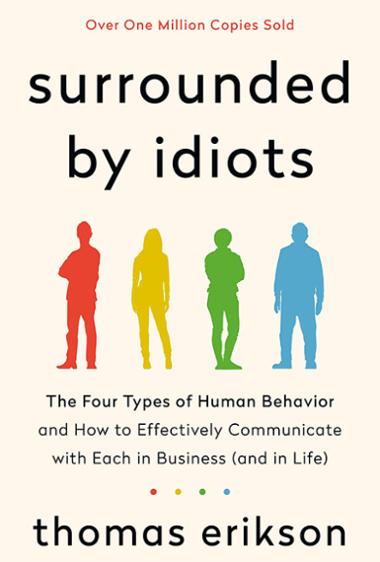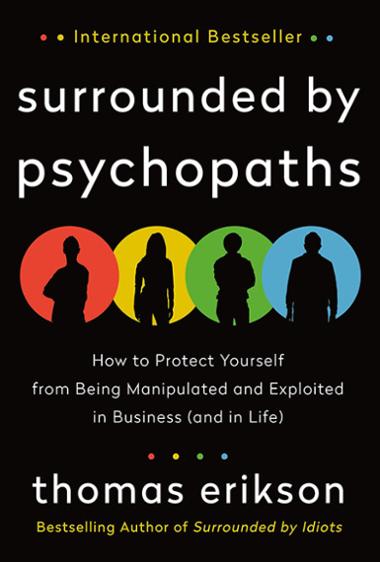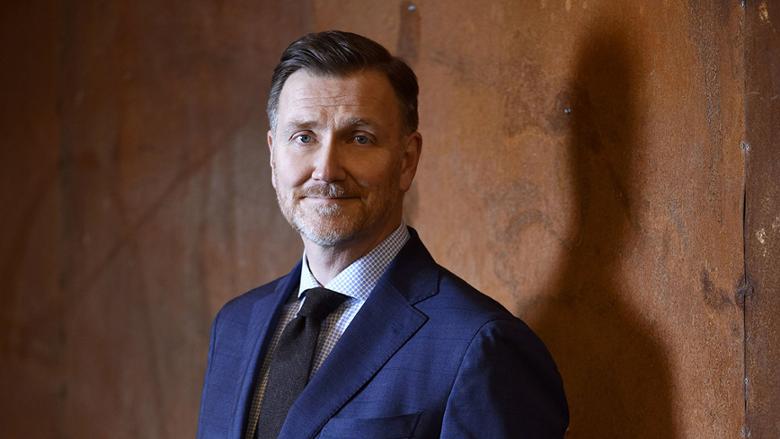Do you feel surrounded by idiots? Behavioural expert Thomas Erikson explains why you'd think so
Bestselling author and behavioural expert Thomas Erikson, who addressed fans at the recent Emirates Airline Festival of Literature, gives Anand Raj OK a few tips on how to improve communication skills and explains why diversity is crucial for a team’s success
Some six minutes into the Zoom interview, I ask Thomas Erikson if he would be able to gauge my personality or describe the kind of a person I am from the conversation we have been having. After all, he is an expert on personality analysis, a behavioural specialist, leadership coach and the author of the bestselling Surrounded by… series of books. Deep inside though, I am a tad apprehensive; I am hoping he will not quote the title of one his books when describing the position he is in right now even if virtually: Surrounded by Idiots.
Luckily for my ego, he has only kind words to say. But more about me later.
First, a little about the man. A Swedish behavioural specialist, Thomas initially worked as a HR manager in Sweden before switching careers to writing.
"I was working with behaviour, personalities and so on, and after some 20 years in that business decided to switch to writing about them," says the 55-year-old who will be addressing readers during the upcoming Emirates Airline Festival of Literature in Dubai.
His debut crime novel Blandverk (Illusion in Swedish) revolved around a behavioural scientist who helps police solve the case of a serial killer by using the DISC method (DISC stands for the four main personality profiles in the model by that name: Dominance, Influence, Steadiness and Conscientiousness.)
Riding on the success of his first book, Thomas penned more crime fiction all exploring human behaviour and personalities.

"I’ve always been interested in human behaviour – why people are the way they are," he says, dressed in a dapper suit and speaking to me via Zoom from his office in Sweden. "It’s interesting that all humans are different and similar at the same time. While there are differences, we are more similar to each other than we can imagine."
According to the expert, our behaviour derives from our personalities formed from a combination of heritage and environment. While genes are responsible for around less than 50 per cent of our personality make-up, the rest comes from how we were raised, where in the line of siblings we are, our first years in school, among other things.
Understanding yourself
Although Thomas became a manager when he was just 24, he did not enjoy the position "because I was a catastrophe". Keen to improve, he consulted a few well-wishers who suggested he take some personality tests so "you know who you really are and understand a little more about yourself".
He took the test and learnt troubling things about himself. "I received a piece of paper describing who I was. It was scary because it really was spot on. It was not an ‘aha’ moment. Rather, it was an ‘oh no’ moment," he recalls.
Keen to learn more, Thomas began to study and research behaviour and personality types, and in 2014 published Surrounded by Idiots. An instant bestseller, it was translated into 43 languages (the Arabic version is going to be out later this month) and available in more than 100 countries. With more than 1.5million copies in print, the book explains, in pretty simple terms, why occasionally in group settings, you experience feelings of just what the title says.
It discusses how people function and how we are ‘wired’. Using a colour scheme of red, yellow, green and blue to describe different behaviours and personalities, Thomas explains how specific communication styles can be followed once you recognise where people fit in the four-colour palette.
If the popularity of the book is any indication, the title clearly resonated with a lot of people. After all, who has not muttered that line under their breath when storming out of a meeting convinced no one in the room can understand them. Haven’t you thought of the title when the conversation did not go as planned or expected with your friend, associate or even your partner?
"I used that term intentionally for the title," Thomas says, "because everybody recognises that feeling, that emotion... that nobody understands me, nobody listens to me, nobody pays attention to me."
The behavioural expert admits that it is interesting to read about oneself and understand who you are so you can raise your self-awareness quotient. "But it is also interesting to read about other people and maybe laugh at them a little bit too," he says, grinning, his eyes twinkling behind his spectacles.
"We have always been fascinated by how hard it is to communicate, how difficult it is to make people listen to you, how difficult it is for you to listen to them because some people are just not interested; these dynamics are really fascinating and interesting."
Thomas uses the popular DISC method to explain the 2X2 matrix that divides people into four boxes based on personalities – extroversion, introversion, task orientation and people orientation.
The boxes are colour-coded for pedagogical reasons, he says. In very simple terms:
• Reds are dominant. They are fast forward thinkers and take quick decisions.
• Yellows are extroverts but people oriented. They are creative and optimistic. "Even if it’s raining outside, the Yellows are ‘the sun is actually shining somewhere’ kind of people. Very positive."
• The Greens are more laid back, more caring and sharing, good listeners, good team players but a bit of introverts.
• The Blues are more interested in details and facts. They are the accountants, the tax people, surgeons and lawyers.
The boxes, Thomas says, are just the basics. "People are usually a combination of two of these traits, which is what makes us totally complicated," he says, with a smile.

He sums up the various colours thus: "The Yellows come up with the ideas, the Reds say ‘great, let’s do it’, the Greens carry it out, and the Blues evaluate it."
Is it easy to categorise people into four boxes? I ask.
"See, even though this is a Zoom interview, I’m trying to figure out what kind of a person you are; and you are doing the same with me as well, right? We do this all the time. The only difference is that I use a system. I have this model in the back of my head and I try to figure out things to adapt and adjust myself so we can get along in a good way."
So which colour am I? I ask.
Thomas smiles as he leans back in his chair in his well-appointed library.
"You are probably more of an extrovert than an introvert. You are positive, you have what we call an ‘open face’. You do not scrunch up your eyes or stare at me very closely. You are more of a people’s person; you like relationships. You like to talk to people, listen to them... you are interested in conversations and communicating with people. So, that would make you mostly yellow. But not completely. There is a hint of something else that I’ll surely get to know as we progress."
Without trying to act like a chameleon, I ask if it is possible for a person to choose to move from colour to another.
If you want to go from green (introversion) to a more yellowish area (more of an outgoing person) yes, you can train yourself by observing and practicing behaviours of an extrovert and modelling your behaviour on his or her, says Thomas. "But importantly, you should never violate who you really are. You should not change your persona. You can adapt yourself for a couple of hours maybe but it’s always best to be you."
Why people wear masks
Why do people wear masks, metaphorically speaking, or pretend to be someone else? I ask.
The author of Surrounded by Idiots, Surrounded by Psychopaths and the to-be-published Surrounded by Bad Bosses mulls over the question for a while before explaining that often people don’t want to show others who they really are because "they are afraid of being judged by others".
He offers the example of a person going to a party. "He would like to be treated in a positive way while at the get together so would do everything possible to make people like him." He would try to show off that he has a good sense of humour by cracking jokes, saying something smart, interacting with as many people as possible. But if that is not the real him, it would be a struggle for him to continue keeping that up for a long time. Often, this is a reason many people feel exhausted not just physically but even psychologically after returning from a social do.
Thomas believes a big challenge is getting people together from diametrically opposite quadrants. "For instance, blues and yellows are not even from the same planet when it comes to many things," he says, with a chuckle.
While the Yellows are positive and creative, and constantly planning of things to do, Blues are more practical and detail oriented. The Yellows might say, "Look here, this and this can take us to the top of the mountain and the Blues will say ‘What? I don’t even see the road’. That’s because the latter is looking for reports, analyses…"
For such people in a relationship, it is important they communicate regularly and arrive at a middle ground on various issues, he suggests.
The base for all good communication, though, is to first understand who you are and where you are from before trying to understand who the other person is, says the expert. He offers an illustration:
"Suppose I go to my travel agent and say I want a flight ticket to Abu Dhabi, the agent will say ‘fine, but where do you want to fly from?’ Now, what if I were to say ‘never mind that, I just need a ticket to Abu Dhabi’, how will he be able to help? So, it’s important you have a starting point.
"It’s the same thing when we communicate with humans. You need to understand the starting point and the starting point is always you," he says. And this is exactly what he hopes his books will be able to help people learn.
"If you don’t know how you are interpreted and perceived by others, how can you adapt to a situation involving them. So be clear about who you are and what kind of a person you are. That will help you when dealing with others," he advises.
The perfect team
To expand the talk from individuals to groups, I ask him for tips on how a manager or supervisor can make the most of his or her team.
"Ahh," says the man who has trained more than 5,000 executives in leadership skills, "there are quite a few ways." First, pay attention to every individual in the team and consider them as individuals not as just ‘a member’ of the team.
Next, get to know who you are getting along best with or who you work best with, and why.
Identify the people you do not seem to be getting along well with and explore the reasons for it. You can ask yourself questions like ‘Why do I get angry every time that person opens his mouth? What is it that he’s doing or saying that makes me angry, frustrated or annoyed?’ You need to be honest and objective in your assessment.

You also need to keep in mind your common team goals. Remember any team is only as good as its weakest link.
You need to keep pointing out to the team the direction to be going in.
So is the best team the one with lots of reds or yellows?
"Not really," he says. For one, it would be difficult to find a lot of individuals of the same colur in an organisation, he says. "While the least common colour is red and most common is green; it is roughly five greens for every red."
Thomas believes that the best team is one that mirrors diversity; so, ideally, have all four colours in the team. That would lead to a lot dynamics. "All members of the team will not act, think or do the things the same way. There will be more interesting points of view from different members and probably at the same time. These could work well for the team," he says.
A keen advocate of inclusion, Thomas believes we need to welcome our differences, and observe and learn from each other rather than getting frustrated and irritated by characteristics and personalities. "We are all a lovely, nuanced mix of many colours, all waiting to be discovered. Remember that if everyone agrees, development is impossible." So every team needs to have a mix of shades.
Even as we wind up the interview, I decide I must find out what shade I am.
Much later I ask the wife if she agrees with what Thomas said about me.
"You like to listen to people? Communicate?" she asks quizzically. "I often wonder whether you are even listening to what I am saying."
I must try to figure out which colour she is.
Colours in a nutshell
Reds are dominant, yellows inspirational, greens stable and blues analytically minded. Goal-oriented and competitive, Reds believe achieving results is everything and they work towards it, often seemingly bullish and even aggressive.
Yellows are happy, cheerful, optimistic and believe the glass is half full rather than half empty. They are solution driven, enjoy life and look for opportunities to make their life better. Some might see them as people who don’t take things seriously.
Greens are loving, friendly and are willing to care and share. They are ready to lend their shoulder for someone to cry on or to rest, and are also ready to lend their ears willingly. They are good team workers and work to keep the team tightly knit. The flip side is some people perceive them as imprecise and as pacifists who would avoid a conflict at any cost.
Blues believe in analysis and are detail-oriented. Perfectionists, they seek facts and evidence when tackling just about any project. They are keen to give their best and demand the best in everything. The flip side? Not great conversationalists, too stone-faced, and nit picking.